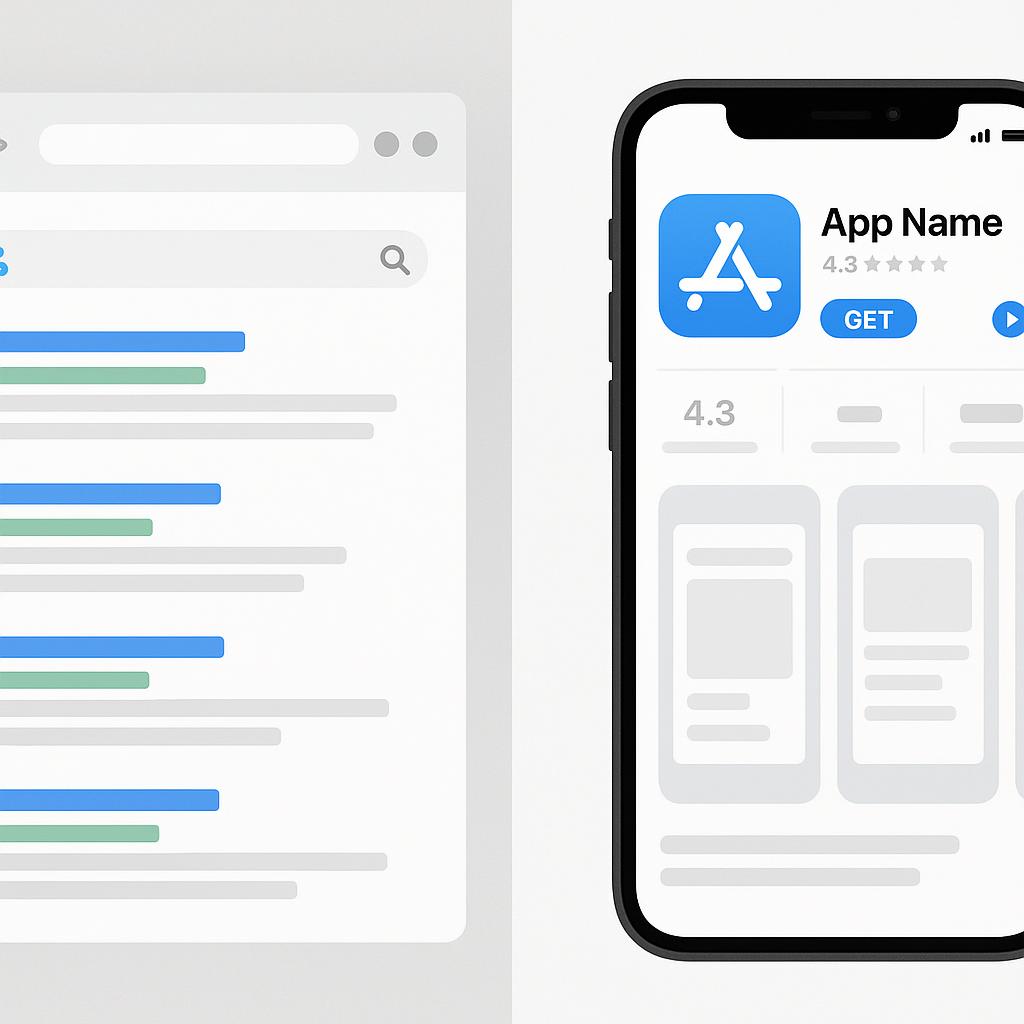Getting your product or service noticed is crucial. You've likely heard of SEO, Search Engine Optimization, but what about ASO, App Store Optimization?
While both aim to improve visibility, they operate in distinct environments with different rules.
Understanding these differences is key to crafting a winning digital strategy.
Let's dive into what makes ASO and SEO unique, how they overlap, and why a holistic approach is essential for modern businesses.
What is SEO? Boosting Your Web Visibility
Search Engine Optimization, or SEO, is the practice of increasing the quantity and quality of traffic to your website through organic search engine results. Think of it as making your website a shining beacon that Google, Bing, and other search engines can easily find and recommend to users.
What does SEO involve? It's a multi-faceted process. Firstly, keyword research is paramount. You need to understand what terms your target audience types into search engines. Once you have those keywords, you integrate them naturally into your website's content, headings, and meta descriptions. Secondly, creating high-quality, valuable content is crucial. Search engines reward websites that provide genuinely helpful and informative articles, blog posts, and pages. For example, a well-researched blog about 'the best home security systems' would rank higher than a sparse page. Thirdly, backlinks, links from other reputable websites to yours, act as votes of confidence, signaling to search engines that your site is trustworthy. Lastly, technical SEO ensures your website is fast, mobile-friendly, and easy for search engine crawlers to navigate.
SEO is a continuous effort. It's about building authority and relevance over time, ultimately driving more organic visitors who are actively searching for what you offer. This is where tools like FeedPal shine. They simplify the process of generating SEO-optimized blog articles, helping you create that valuable content that search engines love and users discover.
What is ASO? Enhancing App Discoverability
App Store Optimization, or ASO, is the process of improving the visibility of a mobile app within app stores, like Apple's App Store and Google Play, and increasing its conversion rate. Instead of websites, ASO focuses entirely on mobile applications.
Why is ASO important?
With millions of apps available, simply launching your app isn't enough.
Users need to find it. ASO involves several critical elements. The app title and subtitle are incredibly important, as they are often the first text users see and contribute significantly to search rankings within the app store. Keyword fields allow you to explicitly tell the app store what your app is about. Beyond text, visual assets play a huge role. Compelling screenshots and a short app preview video can dramatically increase downloads, showing users what your app does before they even install it. A well-written, concise app description also helps. Finally, ratings and reviews are vital social proof. Positive reviews signal to both potential users and the app store algorithms that your app is high quality and worth downloading. For instance, an app with 4.5 stars and hundreds of positive reviews will naturally attract more downloads than one with 2 stars and few comments.
ASO is about making your app stand out in a crowded marketplace, encouraging users to click that 'Get' or 'Install' button.
Key Differences Between ASO and SEO
While both strategies share the goal of increasing visibility, their environments dictate their tactics.

Platform: SEO targets traditional web search engines like Google and Bing. ASO, on the other hand, is exclusively for mobile app stores, primarily Apple App Storeand Google Play.
Ranking Factors: SEO involves a vast array of factors, including content quality, backlinks, site speed, and mobile-friendliness. ASO's factors are more contained within the app store ecosystem, focusing on elements like app name, subtitle, keywords, screenshots, video previews, and crucial user ratings and reviews.
Content Length and Type: SEO thrives on extensive, informative web content, like long-form articles, guides, and blog posts. ASO relies on much shorter, impactful textual elements, such as app descriptions, titles, and subtitles, alongside highly engaging visual content.
Keyword Usage: In SEO, keywords can be integrated throughout pages and posts, often in longer, more natural phrases. ASO keywords tend to be more concise and direct, often single words or short phrases, entered into specific keyword fields or used in the title and subtitle.
Metrics: SEO success is measured by website traffic, bounce rate, conversion rates on web forms, and search engine rankings. ASO success is primarily measured by app downloads, app store rankings, user ratings, reviews, and retention rates within the app.
Key Similarities Between ASO and SEO
Despite their differences, ASO and SEO share fundamental principles that highlight their common goal: connecting users with relevant content or products.
Keyword Research is Central: Both strategies begin with understanding what your target audience is searching for. Identifying relevant keywords, whether for a blog post or an app, is the foundational step for both.
User Experience Matters: Search engines prioritize websites that offer a good user experience, including fast loading times and easy navigation. Similarly, app stores reward apps that provide a great user experience, reflected in positive ratings and reviews. An app that crashes frequently or is difficult to use will quickly see its ASO efforts diminished.
Conversion is the Ultimate Goal: For SEO, the goal is to convert searchers into website visitors, leads, or customers. For ASO, it's about converting app store visitors into active users. Both are focused on prompting a specific action.
Ongoing Process: Neither SEO nor ASO is a one-time task. Both require continuous monitoring, analysis, and adaptation. Algorithms change, competitor strategies evolve, and user behaviors shift, necessitating regular optimization efforts.
Why Both ASO and SEO Matter for Your Digital Strategy
In today's integrated digital world, you cannot afford to ignore either ASO or SEO. A truly comprehensive digital strategy leverages both to maximize visibility and reach.
Consider this scenario: you've launched a fantastic mobile app. You also have a website that features blog posts and articles related to your app's functionality. Your SEO efforts for the website can drive traffic to your blog, where you can then educate potential users about the problems your app solves. From there, a clear call to action on your website can direct users to download your app from the app stores. Once they land on the app store page, your ASO efforts ensure your app looks compelling and trustworthy, encouraging them to download.
Ignoring one means you're leaving a significant portion of your potential audience untapped. For example, a business with a great app but no web presence might miss out on users who start their journey with a web search. Conversely, a business with a strong website but a poorly optimized app might lose potential users once they reach the app store.
If you have a mobile app, focusing only on ASO can work.
But you are leaving a potential amazing source of traffic. A lot of people keep searching on google for the best apps.
And those research are way easier than on the Apple store
How FeedPal Bridges the Gap
This is where solutions like FeedPal become incredibly valuable for a holistic digital strategy. FeedPal is an AI writer assistant designed to create blog articles and schedule them, significantly improving your visibility on search engines through robust SEO content creation.
But FeedPal's utility extends beyond just web visibility. It also offers an API and plugin that allow you to display your articles directly within your mobile app. This is a game-changer. Imagine, you've optimized your app with ASO to get users to download it. Now, you can use FeedPal-generated content to re-engage your current mobile app users with fresh, relevant information, tutorials, or updates, all without them needing to leave your app. This dual functionality ensures you're covering both the acquisition (via SEO for web and ASO for app stores) and retention (via in-app content delivery) aspects of your digital strategy.

Conclusion
Understanding the distinction between ASO and SEO is critical for any business aiming for digital success. While they operate in different spheres, both are indispensable for attracting and engaging your target audience. SEO optimizes your web presence for search engines, while ASO optimizes your app's presence in app stores. By embracing both, you create a robust, multi-channel approach that maximizes your reach. Tools like FeedPal empower you to streamline your content creation for SEO and simultaneously leverage that content to re-engage your mobile app users, ensuring you're visible and valuable wherever your audience may be. It's time to supercharge your digital presence with a strategy that covers all bases.
